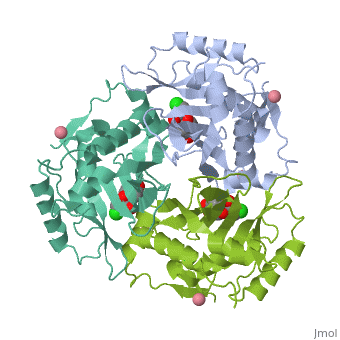Sandbox 156
From Proteopedia
(Difference between revisions)
(→Reaction of CAT III) |
(→Reaction of CAT III) |
||
| Line 14: | Line 14: | ||
[[Image:Picture2.jpg|500x400 px|center]] | [[Image:Picture2.jpg|500x400 px|center]] | ||
| - | In the first step of the reaction, Histidine-156 abstracts a proton from the 3-hydroxyl of chloramphenicol, promoting a nucleophilic attack from the deprotonated oxygen to the thioester bond of the acetyl-CoA. The intermediate produced, 3-acetylchloramphenicol, then rearranges non-enzymatically to 1-acetylchloramphenicol. Regeneration of the 3-hydroxyl allows another CAT III catalyzed nucleophilic attack to another acetyl-CoA and a 1,3-diacetylchloramphenicol product is formed. PMID:2015231 | + | In the first step of the reaction, Histidine-156 abstracts a proton from the 3-hydroxyl of chloramphenicol, promoting a nucleophilic attack from the deprotonated oxygen to the thioester bond of the acetyl-CoA. The intermediate produced, 3-acetylchloramphenicol, then rearranges non-enzymatically to 1-acetylchloramphenicol. Regeneration of the 3-hydroxyl allows another CAT III catalyzed nucleophilic attack to another acetyl-CoA and a 1,3-diacetylchloramphenicol product is formed. <ref>PMID:2015231</ref> |
==Structure== | ==Structure== | ||
Revision as of 04:56, 21 March 2010
Contents |
Chloramphenicol Acetyltransferase Type III
Chloramphenicol acetyltransferase type III (CAT III) is an enzyme which catalyzes the transfer of an acetyl group from acetyl-CoA to hydroxyl groups of chloramphenicol. CAT III is a trimeric protein
Introduction
Reaction of CAT III
In the first step of the reaction, Histidine-156 abstracts a proton from the 3-hydroxyl of chloramphenicol, promoting a nucleophilic attack from the deprotonated oxygen to the thioester bond of the acetyl-CoA. The intermediate produced, 3-acetylchloramphenicol, then rearranges non-enzymatically to 1-acetylchloramphenicol. Regeneration of the 3-hydroxyl allows another CAT III catalyzed nucleophilic attack to another acetyl-CoA and a 1,3-diacetylchloramphenicol product is formed. [1]
Structure
|
References
- ↑ Murray IA, Lewendon A, Williams JA, Cullis PM, Shaw WV, Leslie AG. Alternative binding modes for chloramphenicol and 1-substituted chloramphenicol analogues revealed by site-directed mutagenesis and X-ray crystallography of chloramphenicol acetyltransferase. Biochemistry. 1991 Apr 16;30(15):3763-70. PMID:2015231
| Please do NOT make changes to this Sandbox until after April 23, 2010. Sandboxes 151-200 are reserved until then for use by the Chemistry 307 class at UNBC taught by Prof. Andrea Gorrell. |


